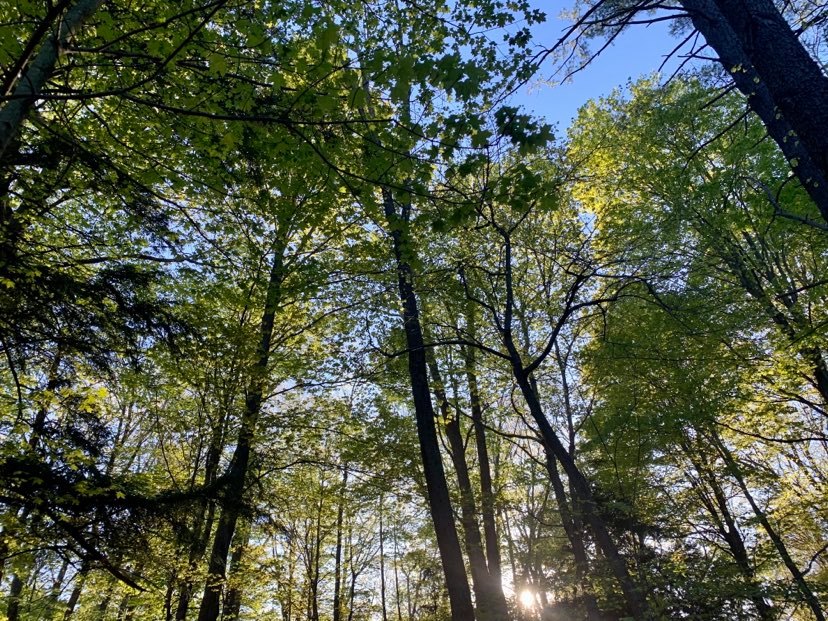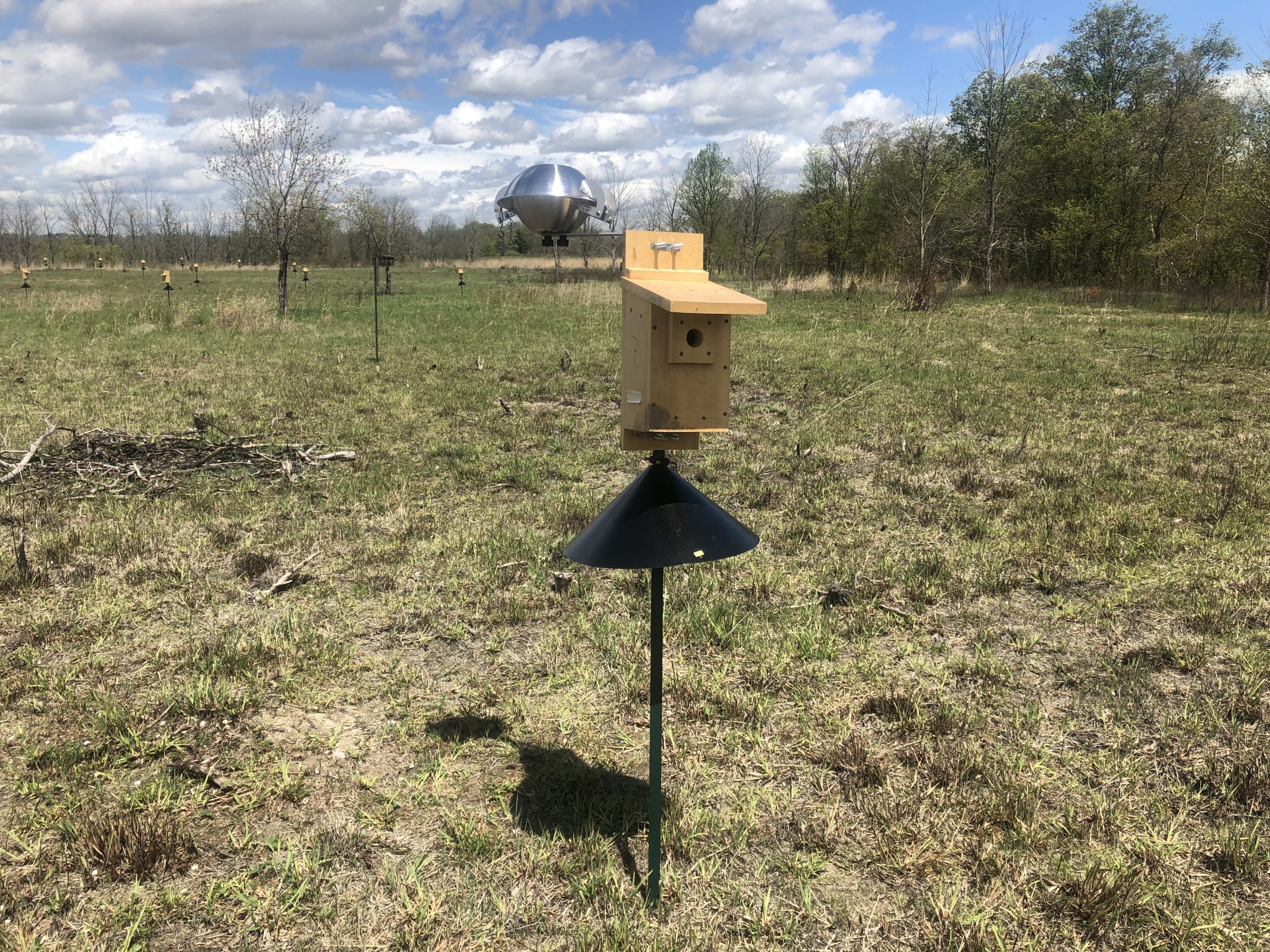Ongoing Research Projects

Smithsonian Dynamic Tree Plot
|
In 2013, a team from McMasters Department of Biology led by Dr. Susan Dudley and Dr. Chad Harvey, established a Smithsonian Dynamic Tree Plot to measure forest health over time.
The teams of students and volunteers used equipment generously lent by Civil Engineering to precisely impose a grid onto the property. The grid is a 500m X 400m square, with stakes every 20m (to create 20m x 20m quadrats).
|
By identifying, locating, and measuring every tree in the forest, the team was able to establish a baseline and track how the forest changes over time. This data can be used to better understand invasive species, species at risk, forest growth, and the local effects of climate change.
Over 22, 000 trees have been surveyed to date.

Bird Audio Recorders
As part of their bird study projects, The Hamilton Naturalists’ Club, has multiple bird audio recorders placed around the property. The bird audio recorders serve to record bird species diversity and presence on the property.

Bobolink and Meadowlark Solar Panel Audio Playback
In the tallgrass prairie and adjacent old field meadow, there are two sets of solar panel powered audio playback devices that play the calls of Bobolink and Eastern Meadowlark.
Bobolink and Eastern Meadowlark are two threatened species at risk ground nesting grassland birds. The project is led by Dr. Jim Quinn, from McMaster’s Department of Biology and aims to encourage Bobolink and Eastern Meadowlark to nest at McMaster Forests grasslands.

Deer Exclosure Fencing
Undergraduate and graduate researchers from Dr. Susan Dudley’s lab, from McMasters Biology Department are conducting a study on the effects of deer browsing on sapling growth in forests. Several deer exclosure fences are set up in the forest in an effort to monitor and compare sapling growth with and without deer browsing.

Blue Bird Boxes
Within the tallgrass prairie and adjacent old field, you may spot several blue bird boxes. This is a project led by The Hamilton Naturalists’ Club, and helps to encourage blue birds to nest on the property. Most blue bird hatchlings are tagged and nesting pairs are recorded and monitored. There are currently 7 sets of two blue bird boxes located in the area.

Bee Monitoring
It’s a buzzin’! Each year since 2014 undergraduate and graduate students from Dr. Susan Dudley’s lab, from McMasters Biology Department survey the bee populations at McMaster Forest using a variety of methods, including pan traps, vane traps, and sweep netting. This project is expanding the current bee research in Hamilton and Ontario.

Tree Swallow Toxicology & Climate Change
25 tree swallow boxes were installed by the lab of Dr. Emily Choy in the tallgrass prairie to research the interactive effects of climate change and contaminants in tree swallows. These boxes act as a “clean” reference colony to those in Hamilton Harbour near wastewater treatment plants.

Snake Cover Board Study
Weekly surveys over the summer and early fall are conducted by Nature at McMaster staff as part of a joint collaboration with Ontario Nature’s Long-Term Monitoring Protocol for snakes. Four species have been recorded to date, including Eastern Gartersnake, Eastern Milksnake, Dekay’s Brownsnake, and Northern Red-bellied Snake.
Research Works
Effects of Deer Browsing on Soil Nutrients and Regeneration Dynamics in a Carolinian Old-Growth Forest of Ontario Learn More
Published Paper
Don, S. K., Anyomi, K. A., & Dudley, S. A. (2024). Effects of Deer Browsing on Soil Nutrients and Regeneration Dynamics in a Carolinian Old-Growth Forest of Ontario. Sustainability, 16(23), 10589. https://doi.org/10.3390/su162310589
First Canadian bee species records (Hymenoptera: Apiformes) collected from tallgrass prairie and oak savanna in southern Ontario, Canada Learn More
Published Paper
Sharkey, J.K., Paiero, S.M., & Raine, N.E. (2024). First Canadian bee species records (Hymenoptera: Apiformes) collected from tallgrass prairie and oak savanna in southern Ontario, Canada. Journal of the Entomological Society of Ontario, 155: 1-16. https://journal.lib.uoguelph.ca/index.php/eso/article/view/7841
The native snail shell–nesting bee Osmia conjuncta exploits a local abundance of exotic Cepaea snails, choosing empty shells by size, colour, and microhabitat Learn More
Published Paper
Fanaki, I., Irazuzta, S., & Dudley, S.A. (2023). The native snail shell–nesting bee Osmia conjuncta (Hymenoptera: Megachilidae) exploits a local abundance of exotic Cepaea snails (Stylommatophora: Helicidae), choosing empty shells by size, colour, and microhabitat. The Canadian Entomologist, 155, E22. doi:10.4039/tce.2023.10
Temporal and Landscape Influences on the Bee Community Assemblage of the McMaster Research and Conservation Corridor Learn More
Masters of Science Thesis
Stegman, N. (2023). Temporal and Landscape Influences on the Bee Community Assemblage of the McMaster Research and Conservation Corridor (Unpublished master’s thesis). McMaster University. http://hdl.handle.net/11375/28274
The McMaster Forest Learn More
White Paper
Graziano, N., Baetz, B., & Terryberry, W., The McMaster Forest (2020). Hamilton, Ontario; McMaster University.
Effects of white-tailed deer and invasive garlic mustard on native tree seedlings in an urban forest Learn More
Masters of Science Thesis
Barker, J. (2018). Effects of white-tailed deer and invasive garlic mustard on native tree seedlings in an urban forest (Unpublished master’s thesis). McMaster University. http://hdl.handle.net/11375/24171
Emerald Ash Borer Incidence and Infestation at McMaster Forest Teaching and Research Facility Learn more
Published Paper
Simone, K. (2017). Emerald Ash Borer Incidence and Infestation at McMaster Forest Teaching and Research Facility. The iScientist, 2(1).
Variation in tree and shrub diversity across space, along environmental gradients and through time in a temperate forest in eastern North America Learn More
Masters of Science Thesis
Munoz, S. (2016). Variation in tree and shrub diversity across space, along environmental gradients and through time in a temperate forest in eastern North America (Unpublished master’s thesis). McMaster University. http://hdl.handle.net/11375/19437
Ancaster Creek Biomonitoring Learn More
Poster
Stegman, N., Law, T., & Rayner, E. (2016). Ancaster Creek Biomonitoring. Hamilton, Ontario; Department of Biology, McMaster University.
McMaster Forest Birding Report Learn More
Report
Porter, R. (2015). McMaster Forest Birding Report (Rep.).
Ancaster Creek Monitoring Learn More
Poster
Takahashi, M., Peters, J., Kent, V., & Stegman, N. (2015). Ancaster Creek Monitoring. Hamilton, Ontario; Department of Biology, McMaster University.
